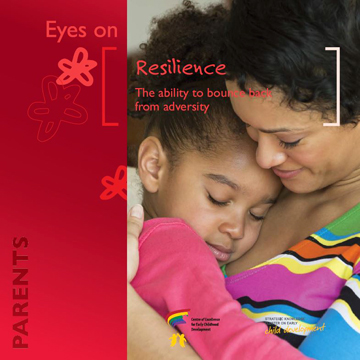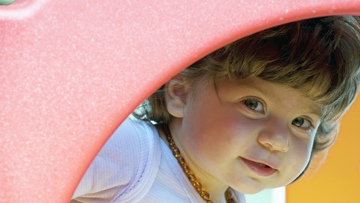When children show healthy development in spite of adversity, it is called resilience. Fostering resilience in young children requires strengthening the family, the community, as well as children’s own personal resources.
Synthesis PDF Complete topic PDFInformation sheets
Download the free PDF version here or purchase hardcopy prints from our online store.
Resilience
Resilience: the ability to bounce back from adversity

Synthesis
How important is it?
When children show healthy development in spite of adversity, it is called resilience. Young children can experience many forms of adversity – sometimes mild, like not being understood by adults when trying to express their needs; sometimes severe, like being exposed to poverty, domestic violence and war. Faced with heightened adversity, some children will develop negative outcomes whereas other children will stay on a healthy course or “bounce back” and resume typical development. What would be called “competence” in children growing up in a low-risk environment becomes “resilience” in children facing adversity. Whether or not children are resilient depends on the resources available to them in their families and communities, and their own emerging personal resources. All young children need to grow up in a safe and nurturing environment and to establish stable relationships with their caregivers. In times of adversity, they need these resources even more. Resilience should thus be seen as a developmental process, drawing on strengths in families, communities and individual children. Young children cannot achieve healthy development on their own when their social support network is in disarray. The main goal of resilience research is therefore to identify the features of children’s lives that can be nurtured or changed to help them develop competence and resilience when adversity occurs. Another key question is how the individual characteristics of young children interact with their environment to promote or jeopardize resilience.
What do we know?
Ongoing studies of resilience in early childhood help us define what can be considered healthy development in context of adversity, what the effects of trauma are at a young age and what factors are associated with resilience. In resilience studies, healthy development is often defined in terms of accomplishing developmental tasks, some of which are universal, such as forming close bonds with caregivers or learning to talk, and some of which are culturally or historically specific, such as learning to weave or hunt bison. Another way of defining good development in adversity is by the absence of symptoms or problems linked to trauma, such as signs of posttraumatic stress disorder (PTSD). Manifestations of PTSD in young children are not very well documented and can differ from those of adults and older children. Children younger than age 3 who suffer from PTSD may have difficulty explaining their feelings. They may also become irritable and/or reenact the traumatic event through play.
Exposure to trauma and neglect in early childhood can affect brain development and thus have long-term consequences. The elements that foster good development in adversity and in milder circumstances are similar. Children need to be fed, protected and stimulated; just as importantly, they need to establish the early interpersonal relationships that are the foundations for cognitive, affective and neurobiological adaptation. Through relationships, young children learn to regulate their emotions, an important skill to deal with adversity, and to develop self-esteem, self-efficacy and coping abilities. As children grow, different relationships play different roles in providing resources and protection.
Still, even in similar circumstances, not all children will develop or bounce back equally well from adversity. This is partly due to their differences in regulation and executive functioning skills (the goal-directed cognitive abilities to control thought, behaviour and emotions). Children with better executive function skills are also better able to navigate in a changing environment. Children may inherit genetic variants that make them more susceptible to environmental influences; they will thrive in a positive environment but will suffer more from the consequences of adversity. Resilience is a complex phenomenon shaped by family and community resources interacting with individual characteristics. Supporting resilience in the early years implies empowering families and communities but also taking into account the differences between children that will make interventions more or less successful.
What can be done?
Children who show resilience do not have rare or special qualities; they have better protections and more resources in themselves, their families and their communities. Therefore, the first step to foster resilience in young children is to ensure that they have these protections and resources, including the material resources and stimulation they need, and a context favorable to establishing stable and positive relationships with their caregivers and later with other members of their communities. Encouraging resilience in young children primarily means supporting their families. Children considered resilient generally have parents with fewer psychological symptoms and a stronger social network.
Psychological treatment of young children exposed to traumatic events is usually based in attachment therapy and involves a parent. If they can do so supportively, caregivers could discuss the trauma with children in age-appropriate ways to help them put the event in perspective, regain confidence and move on. It is also important to re-establish a daily routine in a safe environment, even if pre-trauma conditions cannot be fully restored. Interventions targeting the environment to promote resilience in young children should aim at maintaining or reestablishing a context favorable to practicing normal activity and establishing normal relationships.
Another way of fostering resilience in young children could be to help them develop the abilities they can use to cope with adversity and take advantage of available resources. Self-regulation could be one of these skills. Individuals differ in their physiological reactivity to stress and their ability to regulate it, both developing in response to environmental input. More research is needed to examine the complex relationships between physiological reactivity, self-regulation skills and resilience. Executive function skills, like retaining information in working memory, sustaining or shifting attention, and inhibiting automatic responses to perform a goal-directed action, could also play a protective role in high-risk environment. However, exposure to adversity may harm executive function skills. Therefore, since executive function skills seem malleable to intervention, helping children exposed to adversity develop and maintain these skills could be a good way to promote resilience. Although promising, intervention programs targeting children’s skills to promote resilience have yet to show that they can be effective in the long term. Moreover, such programs should take into account children’s differences in their susceptibility to respond negatively to adversity and to respond positively to intervention. Finally, more research aimed directly at documenting the expression of trauma and resilience in children younger than age 5 is necessary to understand their particular needs and develop appropriate intervention programs.
Discover more

How can we boost resilience in children?
Resilient children have protective skills and supportive environments that helps them cope with difficult situations.
Resilience in children can be fostered by:
Providing them with the material resources and stimulation they need.
Supporting stable and positive relationships between them and their parents and other adults in their community.
Fostering self-regulation skills, that enable children to direct their attention, manage emotions, keep track of rules, inhibit their impulses, and control their behaviour in other adaptive ways.
Reducing the level of exposure to overwhelming adversities and other “toxic” risks that threaten child health and development.
The most effective way to build resilience in children is to support their caregivers.
Publications
Resilience in Development: The Importance of Early Childhood
Early Childhood Relationships and the Roots of Resilience
Protective Role of Executive Function Skills in High-Risk Environments

Resources and bulletins
The Encyclopedia also recommends...
Building Resilience in Young Children
Best Start Resource Centre
Center on the Developing Child - Harvard University




